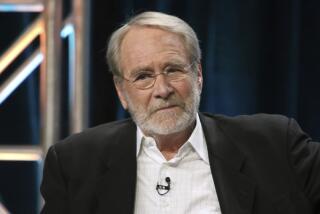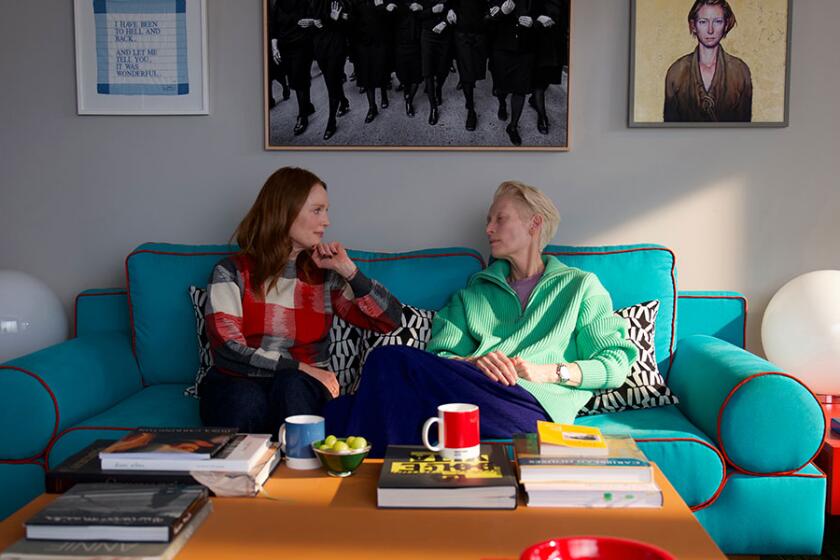Obituary: Patricia Neal dies at 84; Oscar-winning actress
- Share via
Actress Patricia Neal, who rebuilt a troubled career to win an Academy Award only to face a more desperate battle for survival when three strokes left her paralyzed and unable to speak or remember, has died. She was 84.
Neal died Sunday of lung cancer at her home in Edgartown, Mass., her family said in a statement.
A succession of tragedies marked the life of the actress whose bright promise on Broadway in the mid-1940s took her to Hollywood and into a succession of lackluster films, as well as a desperate love affair with actor Gary Cooper and marriage to British writer Roald Dahl.
Her infant son’s brain was damaged when his stroller was struck by a New York City taxicab, a daughter died as a result of measles and then — only a year after she finally won critical acclaim and an Oscar for her portrayal of the weary housekeeper in the 1963 film “Hud” — she suffered three strokes that appeared to end her career.
With the determined help of her husband, Neal recovered sufficiently to return to films, but then lost Dahl to another woman whom she had accepted as a friend.
“I am bitter, yes,” she told an interviewer in 1984, the year after she divorced Dahl. “But I keep remembering that Roald and I had some good times together … and he did so much for me after my strokes .... It was a terrible blow when I found out.”
After 30 years of living in England with Dahl, she moved to a house on Martha’s Vineyard and wished for more opportunities to perform. “My problem is convincing people that I’m well again and able to work,” she said. “Of course, the right side of my body has been a bit of a mess since my strokes, but otherwise I’m fine.”
She never really got over Cooper, the great love of her life. In her 1988 autobiography, “As I Am,” she wrote, “He is one of the most beautiful things that ever happened to me in my life. I love him even now.”
But Cooper remained a married man until his death, and the affair left Neal crushed.
She was born Patsy Louise Neal on Jan. 20, 1926, in a Packard, Ky., mining camp where her father was transportation manager for a coal company. In Knoxville, Tenn., where the family moved while she was in grammar school, she was precocious and showed talent in reciting monologues at church gatherings.
Her parents encouraged her, and she received dramatic coaching at 12. She performed with the Tennessee Valley Players and then studied drama at Northwestern University.
After two years there, Neal went to New York, arriving in 1945 with $60 and a burning ambition. She got an understudy’s job in “The Voice of the Turtle” on Broadway but basically earned her livelihood as a cashier, clerk and model while trying out for parts.
Playwright Eugene O’Neill took an interest in her, and that led to her being hired by the Theatre Guild to appear in the summer tryout of a play in Westport, Conn.
There, she was seen by Lillian Hellman, who wanted her for “Another Part of the Forest,” and by Richard Rodgers, who wanted to cast her as the female lead in “John Loves Mary.” She chose the Hellman play — and that 1947 engagement brought her five major awards, including a Tony and the New York Drama Critics’ Award.
It also brought her several screen offers. She signed with Warner Bros. and landed in Hollywood in December 1948 to star in the film version of the play she had turned down in New York — “John Loves Mary.”
Appearing in the movie with her were actors Jack Carson, Wayne Morris and Ronald Reagan. She also made “Hasty Heart” at Warner’s with Reagan. Years later, when he was in the White House, she told an interviewer, “He was a pleasant fellow. We had adjoining suites and dined together each evening, but he never made a pass at me, dash it all.”
Neal’s film career, however, did not deliver on the promise of her early stage success. Hollywood treated her like the typical starlet. She was the 1949 Junior Rose Bowl Queen.
She made nine films in three years, the most notable of which probably was “The Fountainhead” (1949), in which she portrayed the spoiled, neurotic Dominique of Ayn Rand’s novel. Her co-star was Cooper. She was sneered at by the critics, who also panned “The Bright Leaf” (1950), the second film in which she starred with Cooper.
“Three Secrets” (1950), “Operation Pacific” (1951), “Raton Pass” (1951), “The Day the Earth Stood Still” (1951), “Diplomatic Courier” (1952) and “Something for the Birds” (1952) were hardly films to make her a memorable star.
“Hollywood misunderstood Pat completely,” said writer Barry Farrell in the book he subsequently wrote about her strokes and recovery. “She was cast in heavy romantic roles, silly little comedies, sophisticated, lacquered-beauty roles — everything that was wrong for her.”
Her unhappiness was growing, too, because of her futile romance with Cooper.
“He was married,” she pointed out 30 years later, “and declined to leave his wife. And rightly so.” Some published accounts suggested that the affair led her to a nervous breakdown.
Having been suspended by Warner Bros. for refusing to star in a western with Randolph Scott, Neal decided to leave Hollywood. Later she recalled that she just wasn’t ready for the movies the first time around. “I blame nobody but myself and my immaturity,” she said.
She returned to New York where, in December 1952 she opened in a revival of “The Children’s Hour.” She then played off-Broadway in “School for Scandal.”
In 1953, she married Dahl, an RAF flier who had been shot down early in World War II and assigned to a post in Washington, D.C., where he began writing short stories. It was Dahl who invented the term “gremlins” for the mythical creatures blamed for flying problems during the war.
After their marriage, Neal’s television and stage work enabled Dahl to continue writing short stories at his measured pace. They bought a home in England, about an hour outside of London, and spent part of their time in New York so she could maintain her acting career.
As she rebuilt that career, she played in Broadway in “A Roomful of Roses,” was associated with the Actors Studio and was chosen by Elia Kazan to fill in for Barbara Bel Geddes in “Cat on a Hot Tin Roof.”
She also scored a film success in “A Face in the Crowd” with Andy Griffith. In 1960, she had a small part in the film “Breakfast at Tiffany’s.”
But that same year the first tragedy struck. Her infant son, Theo, was being wheeled across a New York street by a nurse when the stroller was struck by a passing cab. The child underwent a series of operations and was left with water on the brain.
Two years later, her daughter, Olivia, 7, died from brain inflammation after a case of measles.
In 1963 she made “Hud” with Paul Newman. Her portrayal of the slatternly housekeeper brought her an Academy Award as best actress and the British Film Academy award.
“It’s strange to find myself suddenly in demand again,” she said after that abrupt return to the Hollywood spotlight. “My professional life in the last few years falls into two sections, pre-’Hud’ and post-’Hud.’ I’m not a very ambitious woman and had been very happy just living with my family in the country, perhaps making a film every couple of years.”
She then appeared in other films, “Psyche 59” and “In Harm’s Way.”
But in February 1965, at the age of 39, after the first day of filming for “Seven Women,” she suffered a brain hemorrhage while giving her oldest daughter, Tessa, 8, a bath.
She had two more strokes after her arrival at UCLA Medical Center, where she underwent a seven-hour operation.
Neal, who was pregnant, was in a coma for more than two weeks and on the critical list for three. Throughout that time, her husband sat by her bedside day after day talking to her, trying to penetrate the darkness.
When she finally was allowed to return to their rented Pacific Palisades home, Dahl described her as “exceedingly cheerful.” He called her “a tremendous fighter.” But her entire right side was paralyzed. She was partially blind. She had no memory and she could not speak.
Three months later, however, as she left Los Angeles International Airport for her home in England, the actress was able to joke haltingly with reporters about her speech difficulty. She walked with a brace on her right leg and there was lingering evidence of her paralysis. She had a black patch over her left eye.
Back in England, she gave birth to another daughter, Lucy, and went through prolonged therapy at the insistence of her husband, who was determined that she recover. He had her swimming in a hospital pool, walking, playing memory games and doing crossword puzzles. A strong-willed friend, Valerie Eaton-Griffith, worked with her constantly.
“I loathed life when I first went back to England,” Neal subsequently said. “I had exercises to do every day. My husband had people coming in to teach me — three a day. I wanted to commit suicide, but I didn’t know how.”
Farrell said in his book, “Pat and Roald,” that Dahl kept predicting a 100% recovery, which distressed friends who didn’t believe it. But in six months, the actress began to perk up and smile a little.
Late in November 1966, on a day she remembered clearly from then on, she suddenly “wanted to live again.” She said, “When I ‘woke up’ and had been ill for 18 months, I began to like life again.”
In March 1967, she made her first real public appearance since being stricken. At the insistence of her husband, she spoke to 2,000 people in New York City at a benefit for the New York Assn. for Brain Injured Children. In that speech, she told of the friends who, with incredible patience, had struggled to turn “a complete idiot … an enormous pink cabbage … “ into a human being again.
And she gave most of the credit to Dahl: “My husband is a great man. I love him.”
In her autobiography, however, she wrote that she did not love Dahl when she married him but that she admired him and wanted children. As the New York audience applauded her speech, she wrote later in her book:
“I knew at that moment that Roald the slave driver, Roald the bastard, with his relentless scourge, Roald the Rotten, as I had called him more than once, had thrown me back into the deep water. Where I belonged.”
Her husband also pushed her into appearing at the 1967 Academy Awards ceremony to present the best foreign film award. As she did after her New York speech, she received a standing ovation.
Although initially reluctant to attempt stage parts because of her difficulty memorizing lines, Neal was cast in the 1968 film “The Subject Was Roses” with Jack Albertson and Martin Sheen. She portrayed a hateful, pitiful woman worn down by 25 years of marriage.
It was regarded as a triumph. Charles Champlin, then The Times’ entertainment editor, noted that traces of her physical problems, a slight deliberateness of movement and speech, only made her performance more credible.
She had not wanted to do the film, she admitted to a reporter. Her husband made her do it.
And although she said then she was not particularly interested in more movie parts, she worked in “The Road Builder” (a 1970 English film written by Dahl), “Widow’s Nest” (1977), “The Passage” (1979), “Ghost Story” (1981) and “All Quiet on the Western Front” (1980). In 1999, she starred in the Robert Altman film “Cookie’s Fortune.”
She made her television debut in “The Homecoming” (1971), which launched “The Waltons” series. She, however, did not work in the long-running series.
By 1984, she confided to a writer, she was weary of being told she was brave, courageous and plucky. She was, she said, just someone who had absorbed more than her share of rotten luck.
“I’m going to start living my life again,” she said then. “It’s time for good things to happen to me, don’t you agree?”
Neal is survived by her sister, Margaret Ann Vandenoord; her brother, William “Pete” Neal; her children Tessa, Theo, Ophelia and Lucy Dahl; 10 grandchildren and step-grandchildren; and one great-grandchild.
Jones is a former Times staff writer.
More to Read
Only good movies
Get the Indie Focus newsletter, Mark Olsen's weekly guide to the world of cinema.
You may occasionally receive promotional content from the Los Angeles Times.










